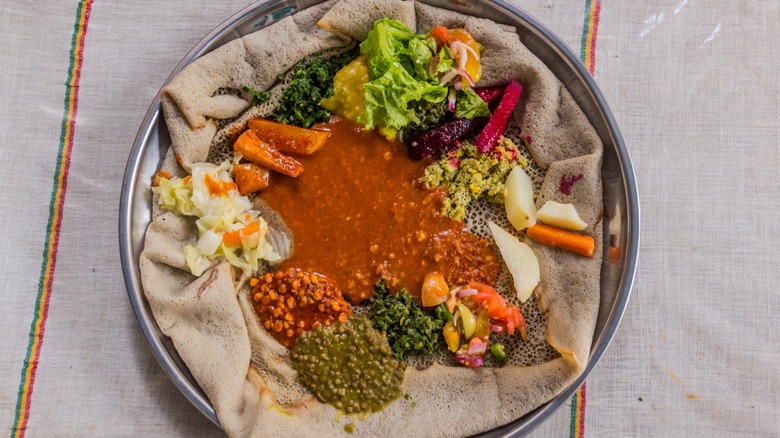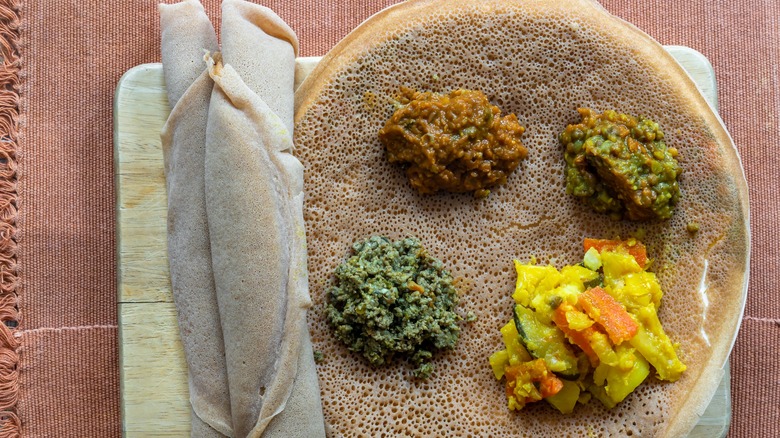Ethiopian Beyaynetu Is A Must-Try For Those Who Like Variety In One Dish
With access to exotic spices from India, Portugal, and East Asia, Ethiopian cuisine is a culinary illustration of the entire East African spice trade. Since the trade's existence, Ethiopian people have used such spices by combining them with their own indigenous grains — creating a cuisine that is distinctly and indisputably their own. Earthy, tart, pungent, sour, and spicy flavors are all present in stews known as wats that are often paired with a teff flour bread known as injera.
Many Ethiopian dishes, such as tibs, doro wat, and kifto, are made from a base of the famous spice blend known as berbere or mitmita and meat. But, in accordance with Ethiopian traditions, there are also a lot of dishes that are completely meat-free. There's shiro, which is made with chickpea power and various vegetables; miser wat, a sort of spicey red lentil dish; kik alicha, a split pea stew; gomen, an Ethiopian style of collard greens; karat alicha, a potato and carrot-based stew; and then there's beyaynetu — a dish that includes them all.
Translating to "a bit of every type," beyaynetu is a dish for those who like variety. Despite being completely vegetarian — some of the wats are even vegan — even omnivorous travelers often return home touting it as their favorite meal. The variety of flavors and textures display vegetables' true potential, and it's no surprise that it's everyone's favorite. Considering the historical significance of vegetarian eating in Ethiopian culture, it's bound to impress.
Vegetarian traditions in Ethiopia
While Ethiopian cuisine celebrates meat in many forms — specifically in the meaty Ethiopian finger food, dulet — it also doesn't shy away from vegetarian options either. Given that a great deal of the population are Orthodox Christians, many Ethiopians follow the fasting days that the church directs. There are about 250 fasting days throughout the year; however, only 180 of them are mandatory. Generally speaking, most of the Orthodox Christian community in Ethiopia follows a weekly fasting schedule prescribed to them by the church, Monday, Wednesday, and Friday, along with the 55-day Lenten fast and other holidays.
While that may sound like a lot, as the Orthodox Church defines it in this scenario, fasting doesn't mean to refrain from eating all food — just meat, eggs, and dairy. For this reason, you can find vegan and vegetarian dishes in abundance all across Ethiopia. Whether it be at a vendor on the street or a sit-down restaurant, there will be one, if not many, vegetarian and vegan options on the menu. From shiro be kibbe to miser wot, you'll have your pick. But, if you want a taste of all the plant-based foods that Ethiopian cuisine has to offer, beyaynetu is one of the most popular and most favored. It's sure to be your go-to.
Beyaynetu components
Like most Ethiopian dishes, beyaynetu is served with the teff flour bread known as injera. Injera has a soft, spongelike consistency that's perfect for soaking up the thick stews that are equally as cognizant in Ethiopian cuisine. In the case of beyaynetu, injera doubles as the plate and the cutlery. It is often served underneath said stews and on the side and is scooped by hand, bite by bite, into the stews. As mentioned above, beyaynetu is a combination of vegetarian dishes, and Ethiopian restaurants will often offer different sizes, from three to four to six different options.
While some restaurants may have a set combination platter for the beyaynetu, if you want a smaller portion, you'll often get to pick which dishes you want. Common accompaniments include shiro, miser wat, kik alicha, and gomen karat alicha. Whatever you get, they'll be served together on top of a big piece of injera. That way, when you get to the end of your meal, it will have soaked up all of the flavors and juices from the stews for you to eat right up.
Like most Ethiopian dishes, beyaynetu is intended to be eaten communally — making it an ideal dish to order for the table. As a group, beyaynetu can be shared as an appetizer or alongside the main courses, and it's a great way to ensure everyone gets their veggies in. But, if you're vegetarian and enjoy variety especially, it makes a great meal for one, too.


